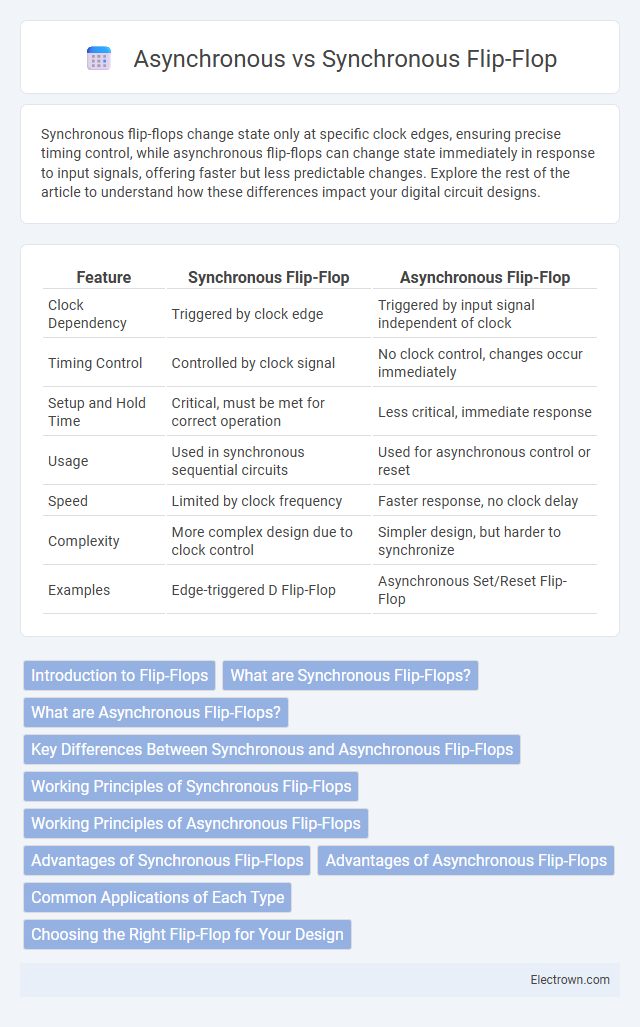Synchronous flip-flops change state only at specific clock edges, ensuring precise timing control, while asynchronous flip-flops can change state immediately in response to input signals, offering faster but less predictable changes. Explore the rest of the article to understand how these differences impact your digital circuit designs.
Table of Comparison
| Feature | Synchronous Flip-Flop | Asynchronous Flip-Flop |
|---|---|---|
| Clock Dependency | Triggered by clock edge | Triggered by input signal independent of clock |
| Timing Control | Controlled by clock signal | No clock control, changes occur immediately |
| Setup and Hold Time | Critical, must be met for correct operation | Less critical, immediate response |
| Usage | Used in synchronous sequential circuits | Used for asynchronous control or reset |
| Speed | Limited by clock frequency | Faster response, no clock delay |
| Complexity | More complex design due to clock control | Simpler design, but harder to synchronize |
| Examples | Edge-triggered D Flip-Flop | Asynchronous Set/Reset Flip-Flop |
Introduction to Flip-Flops
Flip-flops are fundamental digital memory elements used to store and synchronize binary data in sequential circuits. Synchronous flip-flops change state only on specific clock edges, ensuring precise timing control, while asynchronous flip-flops respond immediately to input changes, independent of the clock signal. Understanding these differences helps you design more reliable and efficient digital systems.
What are Synchronous Flip-Flops?
Synchronous flip-flops are digital memory circuits that change their output state only at specific clock signal transitions, ensuring precise timing and coordination within sequential logic systems. These flip-flops rely on a common clock input to synchronize data storage or transfer, making them essential for predictable and stable circuit performance in microprocessors and digital systems. Your design can benefit from synchronous flip-flops for improved timing accuracy and reduced risk of race conditions.
What are Asynchronous Flip-Flops?
Asynchronous flip-flops operate independently of the clock signal, changing their output state immediately when the input conditions are met, which enhances speed in certain digital circuits. These flip-flops are typically used for setting or resetting states instantaneously without waiting for the clock pulse, making them essential in applications like interrupt handling and metastability reduction. Understanding how asynchronous flip-flops function can help you design more responsive and efficient digital systems.
Key Differences Between Synchronous and Asynchronous Flip-Flops
Synchronous flip-flops change states only at specific clock edges, ensuring data stability and timing control in digital circuits. Asynchronous flip-flops respond immediately to input changes without waiting for a clock signal, allowing faster response but risking timing hazards and glitches. The main differences include timing control, data synchronization, and susceptibility to race conditions, with synchronous flip-flops preferred for predictable timing in sequential logic designs.
Working Principles of Synchronous Flip-Flops
Synchronous flip-flops operate based on a clock signal that controls when data inputs are sampled and stored, ensuring data changes occur only at specific clock edges, typically rising or falling. This clocked control synchronizes state transitions across multiple flip-flops in a digital circuit, enabling predictable timing and coordination in sequential logic designs. Internally, the flip-flop uses a combination of logic gates and memory elements to capture and hold input data exactly when the clock signal triggers.
Working Principles of Asynchronous Flip-Flops
Asynchronous flip-flops operate independently of a global clock signal, triggering changes in output immediately when input signals such as set or reset are activated. Their working principle relies on direct input control, causing the flip-flop to respond to inputs without waiting for a clock pulse, enabling faster reaction times in circuits requiring immediate state changes. You can utilize asynchronous flip-flops in designs where rapid response to input variations is critical, especially in asynchronous digital systems or interrupt handling circuits.
Advantages of Synchronous Flip-Flops
Synchronous flip-flops offer precise timing control as they change state only on clock edges, minimizing timing errors and glitches in digital circuits. They ensure predictable operation by coordinating changes with a global clock signal, which simplifies circuit design and improves noise immunity. Your designs benefit from enhanced reliability and easier synchronization when using synchronous flip-flops compared to asynchronous types.
Advantages of Asynchronous Flip-Flops
Asynchronous flip-flops offer faster response times by triggering state changes immediately upon input signal changes, eliminating the need for a clock pulse and thus reducing latency in critical signal processing applications. They enable greater flexibility in designing circuits where timing constraints vary, allowing independent control and reducing clock skew issues common in synchronous systems. This leads to simplified clock distribution and lower power consumption due to the absence of a global clock signal, making asynchronous flip-flops ideal for low-power and high-speed digital designs.
Common Applications of Each Type
Synchronous flip-flops are commonly used in clock-driven digital circuits such as registers, counters, and memory units where data must be precisely timed and synchronized with the system clock to prevent errors. Asynchronous flip-flops find applications in pulse detection, switch debouncing, and asynchronous data transfer where immediate response to input changes is critical without waiting for a clock signal. Your choice between these flip-flop types depends on whether timing synchronization or rapid input response is the priority in your digital design.
Choosing the Right Flip-Flop for Your Design
Choosing the right flip-flop for your design hinges on timing and control requirements: synchronous flip-flops align data changes with a global clock, ensuring precise timing in high-speed circuits, while asynchronous flip-flops respond immediately to input changes, beneficial for event-driven applications. Understanding your system's timing constraints and delay tolerances is crucial to selecting a flip-flop that optimizes performance and reliability. Your design's success depends on balancing speed, complexity, and power consumption factors inherent in each flip-flop type.
Synchronous vs Asynchronous Flip-Flop Infographic

 electrown.com
electrown.com